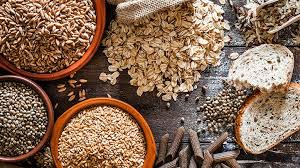WHOLE GRAINS AND BLOOD PRESSURE CONTROL
WHAT’S THE RELATION?
Whole grains are an important part of a healthy diet. Eating more whole-grain foods regularly also may reduce your chance of developing high blood pressure.
And if you already have high blood pressure, eating more whole-grain foods may help lower your blood pressure. Learn more from Dr. Sheldon Sheps, an emeritus Mayo Clinic hypertension and peripheral vascular diseases specialist.
***
What foods are in the Grains Group?
How many grain foods are needed daily?
Note: Click on the top row to expand the table. If you are on a mobile device, you may need to turn your phone to see the full table.
Also in today’s tips …
Pneumonia: Risk factors and prevention Pneumonia is an infection that inflames the air sacs in one or both lungs. The air sacs may fill with fluid or pus, causing a cough, fever, chills and difficulty breathing. Pneumonia can range in seriousness from mild to life-threatening. It is most serious for infants and young children, people older than age 65, and people with health problems or weakened immune systems. Vaccines are available for adults and children to prevent some types of pneumonia. Additional prevention strategies include hand-washing; not smoking; and keeping your immune system strong by getting enough sleep, exercising regularly and eating a healthy diet. Learn more about pneumonia and how to keep you and your loved ones healthy.
Diabetes management: Aspirin therapy for heart health Because diabetes increases your risk of cardiovascular events, daily aspirin therapy typically has been recommended as part of a diabetes management plan. Research has shown that aspirin therapy effectively reduces the risk of heart attack and clot-related strokes if you’ve had a previous cardiovascular event. What’s not clear is whether aspirin lowers the risk of a cardiovascular event if you haven’t experienced one before and you aren’t experiencing symptoms of peripheral artery disease. Learn more from Dr. M. Regina Castro, a Mayo Clinic endocrinologist.
Hearing aids for high-frequency hearing loss Hearing aid manufacturers continue to make improvements by developing hearing aids that are more effective for all types of hearing loss, including high-frequency hearing loss. The advent of digital technology in the mid-1990s resulted in significant hearing aid improvements. Digital hearing aids can be adjusted to match an individual’s unique hearing loss. Learn more from Dr. Paul Takahashi, a Mayo Clinic internist and geriatrician.
Can vitamin C improve mood and decrease anxiety? The link between vitamin C and mood might seem surprising, but people who have vitamin C deficiency often feel fatigued or depressed. Studies have shown improved mood and lowered anxiety from taking vitamin C — even in one group not known to have low vitamin C levels. Learn more from Dr. Brent Bauer, director of Mayo Clinic’s Complementary and Integrative Medicine Program.
Consumer Health: Whole grains and blood pressure control — what’s the connection? – Mayo Clinic News Network #VitaminC #MayoClinic

